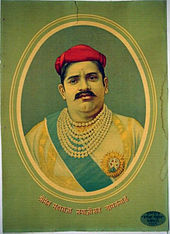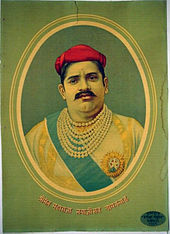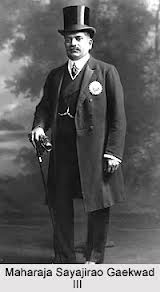
Maharaja Gaekwad of Baroda
Gaekwad (also written as Gaikwad) originated from the royal Kunbi clan, who were the rulers of Baroda, West India. They ruled the princely state of Baroda during the British regime from mid 1800s all the way till 1947. The ruler was referred to as the Gaekwad or formerly as the Maharaja Gaekwad of Baroda.
Origin and History
The Gaekwads gained control of Baroda, when the city was taken away from Mughal control in 1721 by Pilaji Rao Gaekwad, a Maratha General. The city of Baroda was thus granted to the Gaekwads as a fief by the then Peshwa, who was the Maratha ruler. Hence, this is how the Gaekwads established themselves as independent rulers. The Gaekwads also participated in the First Anglo-Maratha War with their Maratha ally. However, in 1802, the British and the Gaekwads concluded a peaceful treaty, with the former granting Baroda’s autonomy in exchange for acceding as an Indian princely state under the British crown.
Immense development was brought about by the Gaekwads. Maharaja Sayaji Rao III, who was crowned the Maharaja in 1875 was a great patron of education and brought about huge infrastructural changes such as a library system, compulsory primary education and he also established the prestigious Maharaja Sayajirao University of Baroda. He was also a great patron of textiles and did much to revive and revitalize the textile industry of Baroda.
After independence in 1947, Baroda became a part of Maharashtra, but owing to linguistic features it was later divided between the states of Maharashtra and Gujarat in 1960.
Style
The Gaekwads were very wealthy and rich Maharajas and according to the Time Magazine in 1908, the Maharaja Sayyajirao Gaekwad was the sixth richest man in the world. The royal court of Baroda, a spectacle of grandeur, was one place that foreigners used to visit from across the world. Another architectural marvel was the opulent Laxmi Vilas Palace which was actually made for the newly wed Maharaja and Maharani. This 170-room palace was only used to house the royal couple!
The Gaekwads were very traditional in their customs and practices and each event was conducted with great finesse and opulence. From processions of embellished horses and elephants, to gem encrusted palanquins and carriages- the Gaekwads provided a true spectacle of royalty to their onlookers. The long silk flowing robes, jewels, intricate turbans and bejeweled swords, exuded their bravery and valor. The state banquets at the palaces were absolutely grand complete with brilliant crystal chandeliers and silverware with a special menu card that described the delicacies that were to be served in both English and Marathi. The Gold Ambari that the Gaekwad rode was crafted out of 70 kilograms of pure gold and this was used on all the state festivals.
The Gaekwads had a special fascination for pearls. Since Baroda was located near the Indian Ocean, therefore it had access to various merchants from Basra who sold the most exquisite pearls. A lot of paintings show the huge gemstones and strings of pearls that the Maharaja wore. In fact, the pearls were viewed as a foil to the shine of the diamonds and gold, which greatly appealed to the royalty. A Maharaja was always viewed by his subjects as a deity and hence, the attire worn by the ruler had to be opulent and exaggerated, replete with fine clothes and plenty of jewels. The lavish ornamentation was necessitated by the Indian Holy Scriptures that bade the kings to appear to his subject in complete ornamentation. Hence, when it came to gems, pearls, gold and silver, the Maharajas had overflowing treasures that they often used generously for gifting and otherwise. One of the most generous gifts by the Gaekwad Maharaja Khande Rao is the ‘Pearl Canopy of Baroda’ which was supposed to be gifted to the Prophet of Islam. This marvelous piece of craft was made with gemstones and Basra pearls, but unfortunately it could not reach its destination as the Maharaja died before its completion.
The Gaekwar wore small, neat turbans favored by the Maratha rulers of western Central India since the early 19th century. The fabric was probably woven in one of the western Indian centres of textile production such as Ahmedabad or Surat. The colors used were that of purple and gold on a yellow or white background. The robes were embellished with sequins and silk piping around the cuffs and front openings. The Angarkha is a traditional man’s robe characterized by the round opening on the chest and a somewhat high waist. It was fastened on one side of the neck and tied at the front.
Influences over the years
Over the period of British rule in India, the Maharajas also tried to adopt some Western styles of dressing, mannerisms and hobbies. From learning the English etiquette to dressing up formerly in the English style, the Maharajas showed a lot of inclination towards adapting British culture. The European staff of the Maharaja was also treated with more dignity, as a picture of Maharaja Sayyajirao Gaekwad with his grandson shows his English nanny in the same frame. If the nanny would have been an Indian, then she would have never been seated next to the Gaekwad in the same picture.
Interesting Facts and Comparisons
- Maharaja Sayajirao Gaekwad III of Baroda chose to take a cow with him during his trip to Europe as he wanted to make sure that his food contained pure ghee and milk.
- Maharani Indira Devi of Cooch Behar, was the daughter of Maharaja Sayyajirao Gaekwad and the mother of Rajmata Gayatri Devi of Jaipur. Maharani Indira Devi had ordered for a hundred pairs of diamond studded shows from Salvatore Ferrogamo, the popular Italian designer.
- Maharaja Pratapsinhrao Gaekwad’s wife Maharani Sita Devi had placed an order for a European tongue scrapper crafted out of gold.
References
Categories: Fashion Cults, Royalty


